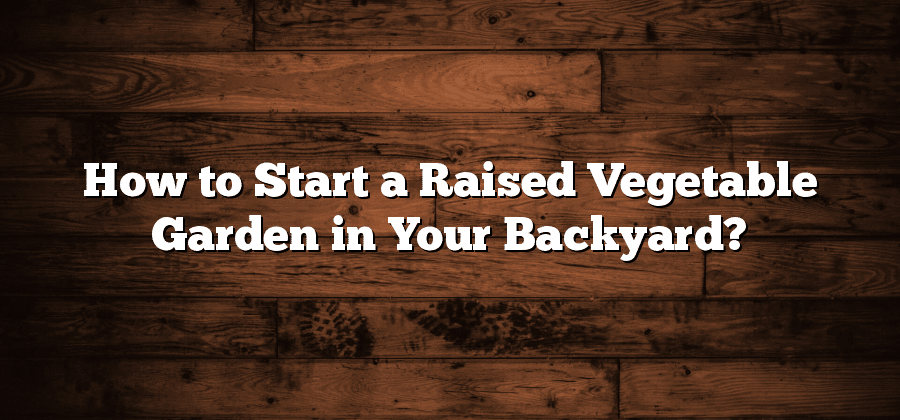Selecting the Ideal Location for Your Raised Vegetable Garden
When it comes to selecting the ideal location for your raised vegetable garden, there are a few key factors to consider. First and foremost, you’ll want to find a spot that receives ample sunlight throughout the day. Most vegetables require at least six hours of direct sunlight to thrive, so choose a location that isn’t obstructed by tall buildings or trees. Additionally, it’s important to select a level area for your garden, as this will make it easier to create and maintain a stable bed.
In addition to sunlight and level ground, you’ll also want to carefully consider the proximity to water sources. Vegetables need regular watering to grow properly, so having access to a water source nearby is crucial. This could be as simple as a nearby outdoor faucet or a rain barrel for collecting rainwater. Furthermore, it’s important to choose a location that is easily accessible for maintenance and harvesting. Consider factors such as proximity to your home, walkways, and potential obstacles like tree roots or utility lines. By carefully evaluating these factors, you can select the ideal location for your raised vegetable garden and set yourself up for a successful and bountiful harvest.
Preparing the Ground for Your Raised Vegetable Garden
To ensure a successful raised vegetable garden, proper preparation of the ground is crucial. The first step is to clear the area of any existing vegetation, including grass, weeds, and rocks. Using a garden fork or tiller, loosen the soil to a depth of at least 8-12 inches. This will help improve drainage and allow the roots of your vegetables to penetrate deep into the soil.
Next, it is important to amend the soil with organic matter to enhance its fertility. Compost, well-rotted manure, or garden soil can be incorporated into the existing soil. Spread a layer of the amendment material over the prepared ground and mix it thoroughly using a garden fork or shovel. This will provide essential nutrients and improve the structure of the soil, ensuring your vegetables have a healthy environment to grow in.
By following these steps, you will establish a solid foundation for your raised vegetable garden. Preparing the ground properly will lead to healthier plants, higher yields, and a more enjoyable gardening experience. So take the time to prepare the ground with care and attention, and soon you will be reaping the rewards of your labor.
Choosing the Right Materials for Your Raised Vegetable Garden
One of the key factors to consider when building a raised vegetable garden is choosing the right materials. The materials you select will not only determine the durability and longevity of your garden, but also the overall aesthetic appeal. Before making any decisions, it is important to assess the specific needs and requirements of your garden.
When it comes to selecting materials for your raised vegetable garden, there are a few options to consider. Wood is a popular choice due to its versatility and availability. Cedar and redwood are particularly favorable as they naturally resist decay and insect infestations. Additionally, treated lumber can be used, but it is crucial to ensure that it is non-toxic and safe for growing edibles. Another option is using composite materials, such as recycled plastic or metal. These materials offer durability and low maintenance, but may lack the organic feel of wood. Ultimately, the choice of materials will depend on personal preferences, budget, and the desired aesthetic for your raised vegetable garden.
Building the Frame for Your Raised Vegetable Garden
When it comes to building the frame for your raised vegetable garden, there are several factors to consider in order to ensure optimal success. First and foremost, you need to select the right materials for your project. Wood is a popular choice due to its durability and affordability. Cedar or redwood are excellent options as they are rot-resistant and can withstand the elements for many years. Avoid using treated lumber as it may contain harmful chemicals that can leach into your soil and ultimately affect the health of your plants.
Once you have chosen the appropriate materials, it is time to start constructing the frame. Begin by measuring out the desired dimensions and marking the corners. Use a circular saw or a handsaw to cut the wood to the desired lengths. It is crucial to make accurate cuts to ensure a tight fit and sturdy structure. Next, attach the boards together using galvanized screws or nails, making sure to pre-drill holes to prevent splitting. Remember to align and level the boards at each corner to create a square or rectangular frame that is both visually appealing and functional.
Filling Your Raised Vegetable Garden with Soil
The final step in creating your raised vegetable garden is filling it with soil. This is a crucial step as the quality of the soil will directly impact the health and productivity of your plants. When selecting soil for your garden, it is important to choose a high-quality, nutrient-rich option. Look for soil that is specifically formulated for vegetable gardens, as it will typically contain the necessary balance of nutrients and organic matter.
Before filling your raised vegetable garden with soil, ensure that it is adequately prepared. Remove any weeds or grass from the garden bed and loosen the existing soil, if present. This will create a solid foundation for your plants to grow. Additionally, consider adding compost or aged manure to the soil to further enrich its nutrient content. By taking the time to properly prepare the ground and select the right soil, you are setting your raised vegetable garden up for success.






